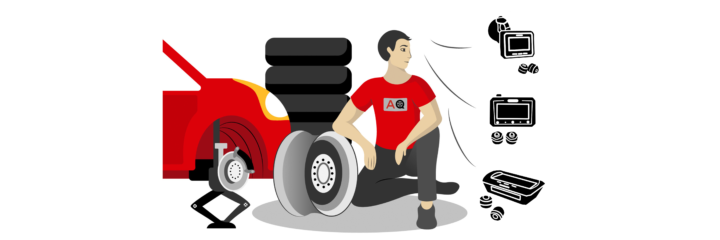You might think there’s no good time to discover that your tires have low air pressure — but it’s certainly better to be aware of the problem when you’re still in the garage instead of when you’re flying down the freeway at 75 mph.
Of course, that means you need to check your tires every time you leave the house, and no one has time for that.
That’s where a tire pressure monitoring system (TPMS) comes in. These devices keep you apprised of the pressure inside your tires without forcing you to get out with a gauge in your hand.
- Choosing the Best Tire Pressure Monitoring System
- Top 10 Best Tire Pressure Monitoring Systems 2026
- 1. Best Overall Tire Pressure Monitoring System: Tymate M12-3 Black
- 2. Best Monitoring System for RVs: EEZTire-TPMS
- 3. Best Premium Tire Monitoring System: TST 507
- 4. Best Monitoring System for Motorcycles: FOBO Bike
- 5. Most Extensive Tire Monitoring: GUTA TPMS
- 6. Best Budget Tire Pressure Monitoring System: Tymate M7-3
- 7. Most Ergonomic Display: Vesafe TPMS
- 8. Best Solar Powered Monitoring System: Jansite Solar
- 9. Easiest Setup: CACAGOO Wireless
- 10. Best Starter Model: Zmoon Universal
- Guide to Buying the Best Tire Pressure Monitoring System for Your Car
- FAQs
- Final Thoughts
Choosing the Best Tire Pressure Monitoring System
Most cars built after 2008 already have pressure monitoring systems built-in as part of their standard safety package. If you have an older car, though, or your existing system is malfunctioning, then you may want to look into buying an aftermarket system instead.
Types of Tire Pressure Monitoring System
The most important thing to understand when shopping for a TPMS is that there are actually two types: indirect and direct.
Indirect TPMS
An indirect TPMS doesn’t actually check the pressure inside your tires. Instead, it uses your vehicle’s ABS wheel-speed sensor to determine how fast each of the tires is spinning.
If one is rolling faster than the others, that’s likely because it’s underinflated. The TPMS will then alert you to the problem, assuming it’s sufficient enough to trigger an alert.
Direct TPMS
A direct TPMS has sensors that attach to each individual tire; these usually screw directly on to the valve stem.
They continuously monitor the exact pressure inside of each tire, and if there’s a problem, they’ll send a signal to the display unit inside the cab.
Generally speaking, direct systems are safer and more accurate. As such, only direct systems made our top 10 list. Still, if you’d like to learn more about whether a direct or indirect system is better for your car, you can skip over to our in-depth breakdown of both types.
High-Line vs. Low-Line Systems
Another thing you’ll need to think about before making a purchase is whether you want your TPMS to be a high-line or low-line system. This will affect how the system displays information.
A high-line system will inform you of the pressure inside each individual tire. If there’s a problem, the display will direct you to the specific tire that needs addressing.
A low-line system, on the other hand, will simply tell you that you have an issue — it’s up to you to figure out where that issue is located.
As you might expect, high-line systems are often more expensive than their low-line counterparts. They’ll save you some time and guesswork, but it’s up to you whether that’s worth the increase in price.
What to Look for in a Tire Pressure Monitoring System
Choosing between indirect or direct systems and high-line and low-line options are the two biggest decisions you’ll have to make, but they’re not the only things you’ll need to consider.
We’ll go into more detail on how all of these factors affect your vehicle within our complete buying guide, but for now, here’s a quick and dirty primer on what to look for before you purchase anything:
The Display Screen
TPMS screens come in a variety of shapes and sizes, and they’re not all powered the same way, either. Some use solar power, while others rely on more traditional outlet charging or in-vehicle USB ports. You need to make sure that whichever one you buy is easy for you to read at a glance, and that keeping it charged is not a hassle.
Customization Options
Many systems allow you to determine when the device will alert you to an issue, as well as customize which issues to bring to your attention. Some also allow you to add or subtract sensors as you see fit. These aren’t essential features, of course, but they really improve the TPMS’s user-friendliness.
Sensor Battery Life
The display screens are usually powered by the car itself, but the tire sensors have little batteries inside them that will die eventually. Once that happens, you may need to replace the entire sensor, so you’ll want to find an option that will give you plenty of bang for your buck.
Durability
This goes hand-in-hand with the battery life issue. Simply put, you don’t want to have to replace the sensors more than absolutely necessary, which means you should find some that can handle the rigors of the road.
Accuracy
Obviously, you want a TPMS that will give you readings you can trust. Most major systems are pretty accurate, but some may be a bit more sensitive than others.
Now that you know what to look for when comparing various TPMS, here are our picks for the best systems on the market today.
| Product | System Type | Line Type | Rating |
|---|---|---|---|
| Tymate M12-3 Black | Direct | High | 5 |
| EEZTire-TPMS | Direct | High | 5 |
| TST 507 | Direct | High | 4.5 |
| FOBO Bike | Direct | High | 4.5 |
| GUTA TPMS | Direct | High | 4.5 |
| Tymate M7-3 | Direct | High | 4 |
| Vesafe TPMS | Direct | High | 4 |
| Jansite Solar | Direct | High | 4 |
| CACAGOO Wireless | Direct | High | 3.5 |
| Zmoon Universal | Direct | High | 3.5 |
Top 10 Best Tire Pressure Monitoring Systems 2026
1. Best Overall Tire Pressure Monitoring System: Tymate M12-3 Black

Editor’s Rating:
Quick Facts:
- System Type: Direct
- Line Type: High
Display Screen
This option from Tymate has a large screen that makes it easy to quickly get the information you need. It’s a bulky option to be sure, but it’s worth it for all the bells and whistles it offers.
It’s a solar-powered model, so there’s no drag on the battery. You can also charge it directly with the included USB charger if you need to use it on a cloudy day.
The screen is designed to be attuned to your needs as well. It has an automatically adjusting backlight that makes it easy to read no matter the time of day, and it will shut off if the car’s stopped running for at least 10 minutes.
Customization Options
There are 5 different alarm modes pre-set in the device: high pressure, low pressure, high temperature, rapid air leakage, and low sensor battery.
You can set the exact values for the pressure and temperature settings, allowing you to decide whether to be informed of every little change or only when something big is happening.
Sensor Battery Life
The sensors each have lithium metal batteries inside, so once they run down, you can replace the batteries instead of having to buy brand-new sensors. That will save you money in the long run, especially since you can get quite a bit of life out of every one (as long as two years in some cases).
Durability
The sensors are quite small, which means it’s unlikely they’ll suffer any damage on the road. They’re quite durable, though, and capable of handling severe weather and similar environmental issues.
Accuracy
The manual says it’s accurate to within 3 psi, but that seems to be a case of giving themselves a little leeway, just in case. As best we can tell using a manual gauge, it seems to be dead-on accurate.
Pros
- Large screen can be read in all kinds of light
- Multiple charging options
- 5 alarm modes
- Allows you to customize alert settings
- Sensors have long-lasting battery life
Cons
- Display unit is fairly bulky
2. Best Monitoring System for RVs: EEZTire-TPMS
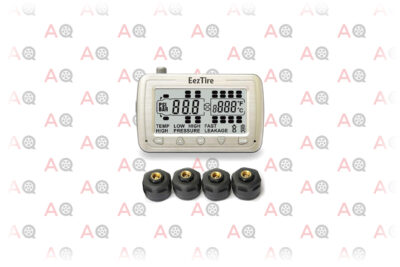
Editor’s Rating:
Quick Facts:
- System Type: Direct
- Line Type: High
Display Screen
The display screen on this unit is very no-frills, and it looks like a low-budget calculator from the 1980s. That’s okay, though, because it does a good job of conveying the information that you need to know quickly and clearly (besides, you’re not going to be watching movies on this thing anyway).
The screen is fairly large as well, coming in at 4.5” x 3”. It’s easy to mount so that it will be out of your way, and the display’s battery lasts for upwards of 50 hours per charge.
Customization Options
The EEZTire is designed for use on RVs, but it allows you to determine exactly how many sensors you want to use at a time — as few as 4 or as many as 14. That makes it a very versatile system indeed, and you can easily switch between towing a trailer and driving your truck on its own without sacrificing safety. It’s not the best choice for motorcycles though, so if you ride a bike you may prefer to check out the FOBO Bike.
You can also choose between regular sensors or those with thicker, anti-theft housings. The latter require a special tool to remove them, deterring thieves but also making things a little more complicated if you need to air up your tires.
Sensor Battery Life
There’s good news and bad news on this count. The good news is that the sensor batteries are cheap and easy to replace, but the bad news is you’ll be replacing them fairly often. Expect to only get around 9-12 months’ worth of use out of each one.
Durability
The sensors are fairly sturdy regardless, but the ones with the anti-theft housing could probably stop a bullet (we don’t recommend trying this, however). You shouldn’t have any issue with these breaking on you unless you’re in an accident, in which case the sensors will be the least of your concerns.
Accuracy
This system is accurate to within 1.5 psi, which is good. You need that kind of precision when you’re dealing with so many tires, so it’s reassuring that you’ll get accurate readings on all of them.
Pros
- Easy to customize setup
- Large, easy-to-read display
- Sensors are very sturdy
- Accurate to within 1.5 psi
- Optional anti-theft capability
Cons
- Sensor battery life is mediocre
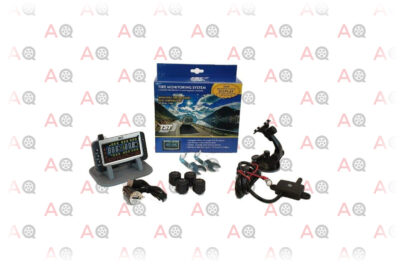
Editor’s Rating:
Quick Facts:
- System Type: Direct
- Line Type: High
Display Screen
This display screen is a little more cluttered than some other options on the market, but that’s because it gives you quite a bit of information to digest. As a result, it’s an excellent choice for professional drivers, but may be a bit of overkill for regular commuters.
Still, the volume of information it provides is reflected in the costs. It’s the most expensive device to make our list, so if you’re looking for something that won’t break the bank, you may prefer a more budget-friendly option like the Tymate M7-3.
The monitor can support up to 28 tires, but the kit only comes with 4 sensors, so you’ll need to upgrade it if you’re driving a big rig. It’s also more difficult to install than a basic TPMS system, so you’ll need to do some wiring to set things up.
Customization Options
You can get this unit to do just about anything you want. It will alert you to changes in pressure, increases in temperature, whether you have a rapid leak, and more.
It also comes with a repeater that you can install if you plan on pulling long trailers. This ensures the signal will always be strong, eliminating faulty measurements due to interference.
You can set the repeater to run on electricity so that it will never die on you; this will guarantee you always get the most accurate readings possible. Still, if you’d like to save on usage, you may prefer a solar powered model like the Tymate M12-3.
Sensor Battery Life
The sensor batteries are easy to replace, and each should last at least a year. That’s more than enough to keep you on the road full-time.
Durability
Each sensor has a thick, anti-theft cover on it. Not only does this protect you from thieves, but it also protects the sensor from dirt and debris.
Accuracy
Each sensor is accurate to within 2 psi, but you’ll likely find the numbers even more reliable than that — especially if you install the repeater.
Pros
- Extremely detailed monitor
- Optional repeater extends signal accuracy
- Thick anti-theft housing on each sensor
- Can support up to 28 tires
- Ideal for professional drivers
Cons
- Complicated to install
4. Best Monitoring System for Motorcycles: FOBO Bike
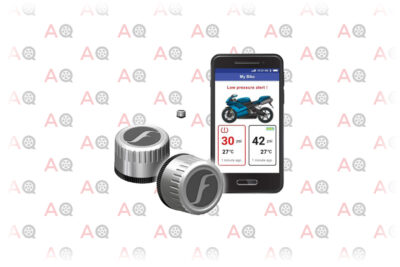
Editor’s Rating:
Quick Facts:
- System Type: Direct
- Line Type: High
Display Screen
Given that this device is designed for motorcycles, it makes sense that they’d skip the bulky monitor for something less obnoxious: in this case, your cell phone. You can also have the sensors transmit data to a Bluetooth headset or smartwatch, if you prefer.
Assuming you use your cell phone, the app is clean and clear, allowing you to get the information you need at a glance. However, it’s not as detailed as some other models, giving you only the air pressure and temperature inside each tire on the screen.
It does offer leak alerts, though, so you should get advance warning before a blowout occurs.
Customization Options
There aren’t many customization options to be had with this model, but that’s not unusual for a motorcycle TPMS — after all, you only have 2 wheels to work with.
However, the sensors come in either gray or black; it’s not much, but it’ll have to do as far as customization is concerned.
Sensor Battery Life
You can get up to 2 years of battery life out of each sensor, which is quite impressive. If you drive your bike constantly, though, that number will decrease, but it should never dip below about 1.5 years.
Durability
The durability will depend in part on how you install the sensors. You can just put them on the existing valve stem, but if it’s rubber, you run the risk of damaging both the sensor and tire if you run over the wrong thing.
The kit comes with metal stems that you can install instead. If you do this, the sensors should be able to handle just about anything the road throws at them.
Accuracy
These sensors are extremely sensitive, and they’ll usually be spot-on with both their pressure and temperature readings. They may be off by a degree here and there, but for the most part you can trust them implicitly.
Pros
- No bulky monitor to deal with
- Cell phone app is sleek and streamlined
- Includes metal valve stems
- Long sensor battery life
- Extremely accurate readings
Cons
- Limited customization options
5. Most Extensive Tire Monitoring: GUTA TPMS

Editor’s Rating:
Quick Facts:
- System Type: Direct
- Line Type: High
Display Screen
The screen is a backlit LCD model that gives you plenty of information at a glance. It’s flat on the bottom, which makes it easy to mount on your dash in an unobtrusive way. That also ensures that it will be in prime position to soak up the sun’s rays, which should keep it charged for as long as you need it.
You can monitor as many as 10 tires with it, and you can do so without feeling overwhelmed.
Customization Options
There are 6 different alarm modes, all of which can be accompanied with an LED flash and warning beep if you prefer.
You can also monitor your tire’s condition when parked, as the system monitors pressure even when it’s asleep. This also lets you monitor your spare, so you don’t have to worry about finding you have 2 flat tires at an inopportune moment.
Sensor Battery Life
You should get at least a year out of the sensors, maybe more.
The system’s auto-sleep function helps to minimize the power consumption, yet since the sensors are constantly monitoring the tire pressure, you may see the batteries drained even if the vehicle isn’t driven that much.
Durability
The sensors are big and bulky, and they’re designed to handle all sorts of weather and extreme temperatures. They’re also constructed with anti-slip material, ensuring they’ll stay in place even if you drive down bumpy roads.
Accuracy
The machine is very accurate and tends to be within at least 1 psi. It also boasts a significant sensing distance, as it can dial in at ranges up to 36 feet without the optional repeater. If you splurge on the repeater, that distance can grow to around 45 feet.
This makes the device equally suitable for passenger cars, RVs, trailers, and more. It’s a pricey model, but given its versatility, it’s hard to argue you won’t get your money’s worth.
Pros
- 6 different alarm modes
- Continuously monitors pressure even when car is parked
- Keeps tabs on spare as well
- Anti-slip sensors stay in place well
- Long sensing distance
Cons
- On the pricey side
6. Best Budget Tire Pressure Monitoring System: Tymate M7-3
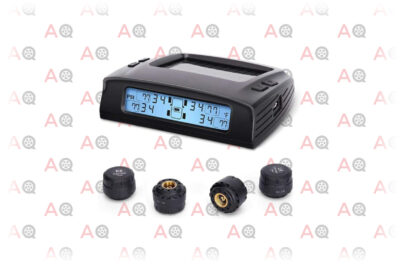
Editor’s Rating:
Quick Facts:
- System Type: Direct
- Line Type: High
Display Screen
The layout of this monitor takes a little getting used to, as it’s not exactly intuitive. It can also be hard to read at-a-glance when you’re on the road.
The display doesn’t give you that much information, as it only shows the pressure and temperature inside each tire. However, it also gives you alerts if there’s a fast leak or dangerous pressure or temperature levels.
It has an automatic backlight that makes it easy to read in any light conditions. The light is muted enough that it won’t distract you at night. It’s also solar powered, with a backup cable that plugs into the cigarette lighter.
Customization Options
This unit lets you set the values for the alarms, so you can be notified for any little change or left alone until something catastrophic happens.
It doesn’t offer much else in the way of bells and whistles, but you sacrifice some features when you buy a unit as low-priced as this one.
Sensor Battery Life
The sensors use inexpensive CR1632 lithium batteries, so replacing them isn’t going to break the bank. You won’t have to do that very often anyway, as they can last up to 2 years with regular use.
Durability
The sensors are thick and hardy, with an anti-theft collar around each. They’re also waterproof, dustproof, and anti-corrosion, so they should last you quite some time.
Accuracy
This is where this unit’s “budget” seams begin to show. It’s not inaccurate, but neither is it as dialed in as some of the other units out there. It has a 3-psi margin of error, which isn’t ideal. It should still be accurate enough to keep you safe, though.
Pros
- Automatic backlight makes it easy to read in all light conditions
- Solar-powered display unit
- Sensors are anti-theft, anti-corrosion, and more
- Display isn’t distracting at night
- Long battery life in sensors
Cons
- Display lacks bells and whistles
- Not many customization options
- Isn’t as accurate as some other models
7. Most Ergonomic Display: Vesafe TPMS
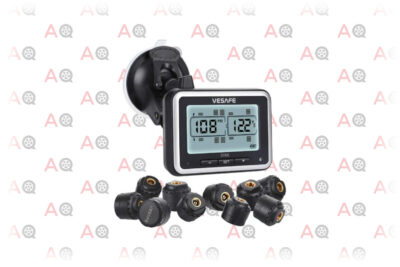
Editor’s Rating:
Quick Facts:
- System Type: Direct
- Line Type: High
Display Screen
One great thing about the monitor for the Vesafe is that it has a suction cup attachment that allows you to stick it to the windshield. This enables you to check it without taking your eyes off the road, making it safer to monitor your tire pressure.
The display doesn’t provide much information normally, so there’s really not much reason to look at it at all. However, once something goes wrong, the alarm activates and the LED starts flashing, making it hard to miss.
You can turn the alarm off easily, but the light will continue to flash until the problem is fixed. This encourages you to take action, but it can be annoying if a minor issue occurs when you’re not in a spot to fix it quickly.
Customization Options
You can’t do much to change the display, but there are plenty of ways to customize your sensor setup. The machine can support up to 17 sensors — 10 in the front vehicle and 7 in the one being towed.
Sensor Battery Life
The manufacturer claims that the sensors will last for 2 years before they need new batteries, but we’d be surprised if you get anywhere near that. Expect to replace them at least once a year.
Fortunately, the system checks for a signal every 5 minutes and will alert you if any of the sensors don’t respond, so you shouldn’t be caught off-guard when one of the units goes out.
Durability
The sensors all have anti-theft rings that should protect them from the elements as well as road debris. If something happens to them, though, they’re protected by a 2-year warranty.
Accuracy
The unit should be accurate within 1.5 psi or 3°C. That’s good but not great; the temperature reading is especially lax. It should still be enough to alert you to a potential problem before it starts, but it’d be nice to have a little more accuracy there.
Pros
- Suction cup attachment for sticking to windshield
- Sensors backed by 2-year warranty
- LED flashes when alarm goes off
- Supports up to 17 sensors over 2 vehicles
Cons
- Display provides limited information
- Sensors have poor battery life
8. Best Solar Powered Monitoring System: Jansite Solar

Editor’s Rating:
Quick Facts:
- System Type: Direct
- Line Type: High
Display Screen
The screen attaches via suction cup to the windshield. Not only does this keep it out of your way, but it also exposes the solar panel to the sun, ensuring you always have a fully-charged monitor. There’s also a USB cable you can use as backup, but it gets in the way if you have to run it to the monitor.
This display is crisp and clean, and the numbers are all quite large, which makes it helpful for being able to see your pressure at a glance.
Customization Options
This model doesn’t give you much leeway in terms of customizing anything. In its defense, that’s partially because the display already gives you everything you need to know, and all of the data that’s not shown will pop up if an issue arises.
Still, that means that, if you don’t like how it looks out of the box, it’s not going to get much better.
Sensor Battery Life
The sensors have a 2-year battery life, and that tends to be about how long they’ll last. That’s especially impressive when you consider that they’re constantly monitoring your pressure as long as there’s power to the display, even if the car is off.
Durability
You can install the sensors as-is or you can install them with the included anti-theft nuts; if you do the latter, their durability will increase significantly.
However, they should be more than capable of withstanding everyday wear and tear regardless of which way you go.
Accuracy
The unit is fairly accurate — when it’s communicating with the display properly, that is. Unfortunately, the signal is often weak, and that can cause a lag in real-time reporting.
This isn’t always an issue, and it’s something that can be mitigated by moving the display to a more suitable location (learn more about how to do that in our dedicated troubleshooting section). Still, it’s an annoying issue that could leave you ignorant of a problem for longer than you should have been.
Pros
- Easy to keep charged due to windshield attachment
- Crisp and clean display
- Good sensor battery life
- Large numbers are easy to read
Cons
- Using USB cable for power is cumbersome
- Limited customization options
- Signal can be weak at times
9. Easiest Setup: CACAGOO Wireless

Editor’s Rating:
Quick Facts:
- System Type: Direct
- Line Type: High
Display Screen
You aren’t likely to find a simpler TPMS than this offering from CACAGOO. It plugs into the car’s cigarette lighter and gives you all the essential information, like tire pressure and temperature.
Using the lighter port keeps the device out of your way, but you’ll sacrifice use of the lighter. Also, you’ll have to look downward to monitor the status of your tires, drawing your focus away from the road.
Customization Options
You can choose whether to display the pressure in BAR or psi units, and you can set the parameters that activate the alarm. You can also choose which temperature units to display.
Beyond that, though, there’s little that you can change on this machine. It’s a bare-bones device through and through.
Sensor Battery Life
The battery life on the sensors is fine; they should last between 1-2 years in most cases. However, the caps for the batteries are prone to falling off, especially if you often drive over rough terrain. As a result, you may have to replace lost batteries every once in a while.
Durability
The sensors are made of plastic. This makes them extremely lightweight, but they won’t stand up to much abuse. They also provide no anti-theft protection whatsoever.
Accuracy
You can expect accuracy to within 1.5 psi from each sensor.
Pros
- Simple to use
- Lightweight sensors
- Good accuracy
- Stays out of the way while driving
Cons
- Requires you to sacrifice use of cigarette lighter
- Sensors aren’t terribly durable
- Little in the way of customization options
10. Best Starter Model: Zmoon Universal
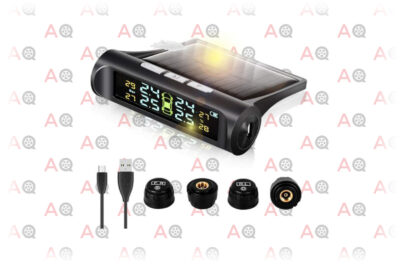
Editor’s Rating:
Quick Facts:
- System Type: Direct
- Line Type: High
Display Screen
The screen has a unique build that’s designed to keep it front and center to ensure it always gets plenty of sun. It can either hang over your dash or attach to the windshield, and either way the solar panel will be perfectly positioned for constant charging.
The screen itself is fairly small, so depending on your eyesight you may have to squint to see it. It has a color display, though, and that makes it easy to see what’s going on with your tires without having to stare at the thing for too long.
Customization Options
There are buttons on top of the monitor that let you cycle through different settings, making it easy to customize both the display and alert settings. It offers a surprising number of features for a unit this inexpensive, as there are 6 alarm modes to choose from.
Sensor Battery Life
There’s no way to sugarcoat this: the battery life is poor. Don’t expect to get more than 4-6 months out of them before you have to swap out the batteries.
That’s a big red flag, but at the same time, it’s not unexpected at this price range. This is a unit for people who just want something for a single long trip, or who want to test a cheap system before switching to something better.
If you’re someone who does a lot of driving, you’re better off going with a professional-grade model like the TST-507.
Durability
The sensors are basic plastic, with no anti-theft nuts to protect them. You likely won’t need to worry about damage from everyday driving, but if you hit something, there’s a good chance they won’t survive.
The monitor isn’t terribly durable, either. It works fine as long as you don’t drop or smack it, but if you accidentally abuse it, it may decide to quit on you.
Accuracy
Everything should work fine until the batteries start to go. At that point, the readings may be off by a few psi, and you may get different readings on all 4 tires.
Again, though, this device isn’t ideal for long-term use. We’d recommend only breaking it out for road trips.
Pros
- Very budget-friendly
- Unique monitor design makes placement easy
- Lots of customization options
Cons
- Poor sensor battery life
- Not the most durable option
- Screen is on the small side
Guide to Buying the Best Tire Pressure Monitoring System for Your Car
Most people don’t think about their tires until something goes wrong. By then, though, a little problem could blossom into a repair job that costs you hundreds of dollars — and that’s if you’re lucky.
Installing a TPMS can help you catch those issues while they’re still in the easy-to-solve stage. That’s not all these little devices can do, however.
Why Is Proper Tire Pressure So Important?
You may think that tires have two settings: properly inflated and completely flat. The fact of the matter is, though, that tire pressure plays an enormous role in everything from how your car handles to how safe it is to drive.
Poor tire pressure can make your car downright dangerous. An under-inflated tire will have more of its surface area exposed to the road, which increases friction and therefore heat. Your tire may get so hot that its structural integrity fails — and blowouts can be deadly.
A blowout isn’t the only way that an underinflated tire can compromise your safety. Tire pressure also affects stopping distance, so if you don’t have enough air in yours, you may end up in an otherwise-avoidable collision.
There’s more than just your safety to think about, however. Tire pressure plays a prominent role in how comfortable your car rides and how responsive it is as well. Also, a poorly inflated tire will wear out more quickly and get worse fuel economy than a properly inflated one, so you’ll save money to boot.
For a simple solution, you could consider buying one of the best tire pressure gauges, but these still require a lot of manual work, and they’re no good for monitoring pressure while you’re actually out on the road. By comparison, a TPMS is a much more complete solution.
As many as 28% of people on the road have at least one tire that’s not properly inflated. If you install a TPMS on your car you can make sure you’re not one of them.
Which Is Better: Direct or Indirect System?
There are positives and negatives to both types of TPMS, but generally speaking, a direct system will be more accurate (and therefore safer) than an indirect model.
Indirect systems won’t always register small changes in a tire’s pressure, so you may have a problem without ever realizing it. Also, they’re not going to help if all of your tires are underinflated.
Direct models have flaws too, however. Since they’ll be exposed to weather, debris, and other environmental factors, they’re more likely to become damaged — and given that they’re more expensive than indirect systems, that can be a pricey problem indeed.
Still, it’s hard to argue for buying an indirect system unless money is extremely tight. They’re just not as accurate, and when you’re dealing with something as vital as tire pressure, accuracy is everything.
How to Install a TPMS
If you’re not exactly a gearhead and the thought of installing anything on your car makes you nervous, don’t worry — a TPMS is incredibly simple to install.
Step 1
Start by taking a reading of your tire pressure with a manual gauge. This will allow you to know if the system is working properly once it’s up and running.
Step 2
Now it’s time to attach the sensors. To do this, all you have to do is unscrew the caps on your valve stems and replace them with the sensors. You should keep the valve caps someplace safe, as you may need them if you take the TPMS off at a later date (but they’re cheap to replace if they get lost, so don’t worry too much about it).
Step 3
Hook up the monitor inside the cab. You’ll need to read the manual to learn how to do this, as the process varies from one system to another, but it’s usually as simple as plugging it into the cigarette lighter or attaching it someplace that the solar panels can get some rays and then turning it on.
Step 4
Once the monitor is on, make sure it’s getting a signal from all 4 tires. If it is, you may notice that the readings are slightly off. That’s totally normal, as the machine has to “learn” how to read your pressure. To teach it, all you have to do is drive the car a certain distance (usually 10 to 25 miles). The manual will let you know the exact distance, so read it carefully.
That’s it — you’re done! Now all that’s left to do is to buy yourself some coveralls and put out your mechanic’s shingle.
Troubleshooting Problems With Your TPMS
A TPMS may be one of the easiest things to install on a car, but that doesn’t mean that you won’t sometimes encounter issues that need solving. If you’re not getting any readings on your monitor, here are a few steps you can take to solve the problem yourself.
Watch Out for Signal Interference
Most aftermarket direct TPMS sensors use Bluetooth or radio signals to communicate with the display monitor. This means that similar devices could be interfering with the signal.
To test this, try moving the monitor to a different location, especially if you have a GPS or other Bluetooth device nearby. If the problem persists or the monitor only works in inconvenient locations, you may need to buy a repeater to extend the transmission distance or find a TPMS with a stronger signal.
Check the Sensors
Sensors can be blocked or damaged by road debris, tar, paint, or even soap from a car wash. Inspect each sensor individually to make sure that everything looks undamaged.
Perform a “Relearn”
Most direct TPMS have to “learn” about your tire (this process is covered in more detail in our installation guide section). Sometimes, though, that learning wears off after a while.
If you suspect this is the case, read the owner’s manual for your system to find out how to perform a relearn. The process will involve resetting the system and then driving your car a certain number of miles (the exact number varies depending on the TPMS).
FAQs
Here are the most frequently asked questions when it comes to tire pressure monitoring systems.
How Does a TPMS Work?
We’ve already discussed the difference between direct and indirect models, and since every item on this list is a direct model, we’ll limit our discussion to how they work instead of going into detail on both.
The sensors are directly attached to the tires via the valve stem, allowing them to constantly monitor the pressure inside. Each sensor has a transmitter that updates the monitor on the status of each individual tire.
If the pressure inside any tire gets below a certain level, the sensor will ping the monitor and trigger an alert. This lets you know that something is amiss with your tire.
Unfortunately, a TPMS won’t help you figure out what’s wrong with your tire, much less fix it. However, it can alert you to issues long before they become full-fledged catastrophes.
How Do I Know if My Car Already Has a TPMS?
According to a law called the TREAD Act, all cars made after 2008 that weigh under 10,000 pounds are required to have a TPMS installed. If your car is older than that, check the owner’s manual to see if it mentions one.
My Car Has a Built-in TPMS. Can I Still Use an Aftermarket Model?
If your car’s existing TPMS has failed, then absolutely. In fact, switching to an aftermarket model is likely cheaper than replacing the one your car came with! Our favorite overall pick is the Tymate M12-3 Black.
Just don’t use both simultaneously, as that will likely result in interference between devices and give you incorrect readings.
Can I Use a TPMS on Any Vehicle?
Yes — provided you get the right TPMS for the job. Some models — like the EEZTire-TMPS — are made especially for RVs, while others like the TST 507 are made for trailers. There’s also the FOBO Bike, which is made specifically for motorcycles.
Each TPMS should state clearly what type of vehicle it’s suited for on the package, but the easiest way to figure it out on your own is to see how many sensors are included. If they only gave you 4, then it’s likely just for a personal vehicle.
What if I Have Dual Rear Wheels?
You’ll need to put a sensor on every single tire, so if you have dual rear wheels you’ll need 6 sensors in all.
Final Thoughts
It may not be the sexiest piece of machinery out there, but a good tire pressure monitoring system could be one of the most valuable additions you could make to your car. Not only will they help keep you safe on the road, but they’ll save you money in the long run as well.
Most of these devices aren’t terribly expensive and they’re a breeze to install, so there’s little excuse not to put one in. They may not be exciting, but they can save your life — or maybe just save you from having to spend an evening changing a flat in the pouring rain.
